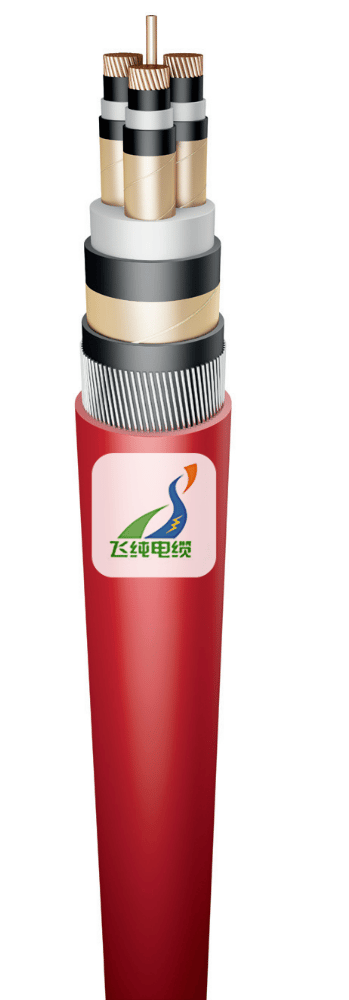Type YHKGXSekFpyn 3.6/6 kV mining cables
Mining power cable with individual shield and copper core,
XLPE insulation, PVC sheath, overall shield,
Flat steel wire armor, fire retardant PVC sheath
Stop flame Low smoke halogen free


This cable is specifically designed for underground mining applications, where conditions can be harsh and safety is critical.
It is built for low-voltage installations (up to 1 kV) in environments with risks of methane or coal-dust explosions and can be used in steep mine drifts or slopes (over 45°).
Construction
The cable is a multi-layer assembly that provides both electrical performance and mechanical protection:
Conductor:
Made of round, multi-stranded copper wires (compacted class 2 per EN 60228).
Individual Shielding:
Each copper conductor is wrapped in an individual shield. This shield can be a conductive tape or a polyethylene-based material combined with a copper tape wrap, which helps to reduce electrical interference.
Insulation:
The conductors are insulated with cross-linked polyethylene (XLPE), conforming to PN-HD 620 S1:2002 (Type DIX 3).
Filler Material:
A filler layer (using unvulcanized rubber or a specialized PVC compound) is used to maintain the cable’s round shape and structural integrity.
Inner Sheath:
A PVC inner sheath (type DMV 31) adds another layer of insulation and protection.
Overall Shielding:
The entire cable is wrapped in an overall copper tape shield to ensure electrical continuity and additional protection against interference.
Armor:
A mechanical protection layer is provided by an armor made of flat steel wires.
Outer Sheath:
The cable’s exterior is covered by a fire-retardant, low-smoke, halogen-free PVC sheath (also type DMV 31), which meets strict safety standards.
Key Characteristics
Coloring:
Insulation: Natural (off-white/grey)
Outer Sheath: Red
Temperature Ratings:
Operating Conductor Temperature: Up to +90°C
Ambient Temperature (for permanently installed cables): Down to –30°C
Installation Temperature (without heating): Down to –50°C
Short-Circuit Conductor Temperature: Up to +250°C
Mechanical:
Minimum Bending Radius: 12 times the cable’s overall diameter
Maximum Tensile Strength: Calculated as 50 times the total cross-sectional area of the conductors (in Newtons)
Electrical Testing:
Test Voltage: Withstands 15 kV AC for 5 minutes at 50 Hz
Flame Spread Resistance: Meets IEC 60332-1-2 and IEC 60332-3-24C standards
Packaging:
Typically available in lengths of 500 or 1000 meters per drum. Custom lengths and packaging options can be provided.
Electrical Specifications
The cable comes in several variants with different conductor sizes (e.g., 3×25 mm², 3×35 mm², up to 3×240 mm²). For each variant, the following parameters are specified:
Insulation Thickness
Inner Sheath (PVC) Thickness
Overall Shield Thickness
Approximate Cable Diameter
Weight (kg per km)
Maximum Conductor Resistance (at 20°C)
In addition, tables provide details on:
Current Carrying Capacity (Ampacity):
For example, a 25 mm² conductor can carry around 146 A at an ambient temperature of +25°C.
Inductance and Reactance:
Unit inductance (in mH/km) and inductive reactance (in Ω/km) are also listed for each conductor size.
Correction Factors:
When multiple cables are installed parallel to each other (stacked on supports), you must apply correction factors to the ampacity:
Stacking Correction (Kg):
1 cable: 1.00
2 cables: 0.93
3 cables: 0.90
6 cables: 0.87
9 cables: 0.86
Ambient Temperature Correction (Kt):
For example, at ambient temperatures above +25°C:30°C → 0.96
35°C → 0.92
40°C → 0.88
45°C → 0.83
50°C → 0.78
55°C → 0.73
Applications
Primary Use:
Designed for underground electrical networks in mining facilities with nominal voltages not exceeding 1 kV.
Suitable Environments:
Can be used in both methane and non-methane areas, including those with a classified risk of methane explosion (Class A or B) and coal-dust explosion hazards.
Installation Conditions:
The armored cable design (using flat steel wire or round steel wires) makes it well-suited for installations in inclined drifts and mine shafts where additional mechanical protection is necessary.
Certifications and Standards
Standards Compliance:
Complies with Polish standard ZN-TF-203: 2014.
Certifications:
Recognized by bodies such as EMAG and WUG.
Meets RoHS requirements (RoHS67).

Frequently Asked Questions (FAQ)
Q: What is the Type YHKGXSekFpyn 3.6/6 kV mining cable?
A: It is a specialized power cable designed for underground mining applications, offering robust mechanical protection and high electrical performance in harsh conditions.
Q: What voltage ratings does this cable support?
A: The cable is rated for 3.6 kV/6 kV, making it suitable for low-voltage distribution networks in mining environments.
Q: What materials are used for the conductor?
A: The conductor is made of round, multi-stranded copper wires, compacted to class 2 per EN 60228, ensuring excellent conductivity and flexibility.
Q: What type of insulation is used in the cable?
A: The cable features cross-linked polyethylene (XLPE) insulation (Type DIX 3), which provides superior electrical and thermal properties.
Q: Why is individual shielding important in this cable?
A: Individual shielding on each conductor minimizes electromagnetic interference (EMI) and ensures stable, high-quality power transmission.
Q: How is the cable mechanically protected?
A: It is armored with flat steel wires, which protect the cable from physical damage and abrasion common in mining operations.
Q: What is the purpose of the overall shield?
A: The overall shield, made from a copper tape wrap, provides a continuous grounding path and further reduces interference, enhancing overall performance.
Q: How does the cable ensure safety in fire-prone environments?
A: The outer sheath is made of fire-retardant, low-smoke, halogen-free PVC (type DMV 31), which helps to contain and slow the spread of flames.
Q: What are the operating temperature limits for this cable?
A: The cable’s conductors can operate up to +90°C, while installation ambient temperatures can go as low as –30°C (down to –50°C for unheated installations).
Q: What short-circuit temperature can the cable withstand?
A: During a short-circuit, the conductor temperature can reach up to +250°C.
Q: What is the minimum bending radius for installation?
A: The cable must not be bent to a radius smaller than 12 times its overall diameter to avoid damaging its structure.
Q: How is the cable tested for electrical insulation?
A: It undergoes a high-voltage test at 15 kV AC for 5 minutes at 50 Hz, ensuring robust insulation integrity.
Q: Which standards does this cable comply with?
A: It complies with the Polish standard ZN-TF-203:2014, along with IEC standards for flame spread resistance (IEC 60332 series).
Q: In what mining environments is this cable typically used?
A: It is used in underground mining facilities, particularly in networks where there is a risk of methane or coal-dust explosions.
Q: How does the cable perform in electromagnetic interference (EMI) reduction?
A: With both individual conductor shields and an overall copper tape shield, the cable minimizes EMI, ensuring consistent performance.
Q: Is the cable suitable for use in steep or inclined mine shafts?
A: Yes, its armored construction makes it well-suited for installation in inclined drifts or shafts with slopes exceeding 45°.
Q: What packaging options are available for this cable?
A: The cable is typically supplied on drums in lengths of 500 or 1000 meters, with the possibility of custom lengths and packaging to meet project requirements.
Q: What are the advantages of using XLPE insulation in this cable?
A: XLPE offers excellent thermal stability, high dielectric strength, and chemical resistance, ideal for the demanding conditions found in mining.
Q: How does the cable ensure reliable grounding?
A: The combination of individual shielding and an overall copper tape shield maintains continuous electrical continuity and effective grounding.
Q: Can this cable be used in explosive atmospheres?
A: Yes, it is designed for explosive environments, including methane and coal-dust areas, and meets the necessary safety classifications for such conditions.
Q: How does the cable handle mechanical stresses during installation?
A: The robust flat steel wire armor protects against impacts, abrasion, and mechanical stress, ensuring durability even in rugged mining sites.
Q: What certifications does the cable hold?
A: The cable is certified by bodies such as EMAG and WUG and meets RoHS requirements, confirming its compliance with environmental and safety standards.
Q: What current carrying capacities does the cable offer?
A: The cable is available in various conductor sizes (e.g., 3×25 mm², 3×35 mm², up to 3×240 mm²) with specific ampacity ratings adjusted for installation conditions and ambient temperatures.
Q: How should the ampacity be adjusted when installing cables in parallel?
A: When cables are installed on top of one another, correction factors (Kg) must be applied—for example, 1.00 for one cable, 0.93 for two cables, 0.90 for three cables, etc.
Q: What adjustment is needed for high ambient temperatures?
A: Correction factors (Kt) must be applied when the ambient temperature exceeds +25°C to ensure the current carrying capacity remains within safe limits.
Q: How does the cable contribute to overall energy efficiency?
A: Its optimized design minimizes electrical losses and interference, ensuring efficient power transmission in demanding mining applications.
Q: What role does the inner PVC sheath play in the cable?
A: The inner PVC sheath (type DMV 31) provides an extra layer of insulation and physical protection for the conductor and its insulation.
Q: How is the long-term reliability of the cable ensured?
A: The combination of robust materials (copper, XLPE, steel armor, and specialized PVC) and compliance with strict standards ensures durability and longevity in harsh mining conditions.
Q: What electrical properties are critical for the cable's performance?
A: Key properties include low conductor resistance, optimal inductance, and controlled reactance, which together contribute to efficient power distribution and minimal energy loss.
Q: How does the cable perform in terms of flame spread and smoke production?
A: The outer fire-retardant, low-smoke, halogen-free PVC sheath significantly reduces flame spread and smoke production, enhancing safety during fire incidents.
Q: What maintenance practices are recommended for this cable?
A: Regular inspections for physical damage, ensuring proper grounding, and adherence to installation guidelines are recommended to maintain peak performance and longevity.
Q: Can the cable be used in both new installations and retrofitting projects?
A: Yes, its versatile design and robust construction make it ideal for new mining infrastructure as well as for upgrading and retrofitting existing systems.






Type YHKGXSekFpyn 3.6/6 kV mining power cable
Type YHKGXSekFpyn 3.6/6 kV Mining Cable is engineered for the toughest underground mining environments. It features multi-stranded copper conductors with individual shielding to reduce interference, surrounded by high-performance XLPE insulation. An overall copper shield enhances electrical stability, while a robust flat steel wire armor and a fire-retardant, low-smoke, halogen-free PVC outer sheath provide superior mechanical protection and safety. Designed to operate reliably even in explosive atmospheres and steep mine drifts, this cable meets strict industry standards for performance and durability.
6/30/20217 min read
